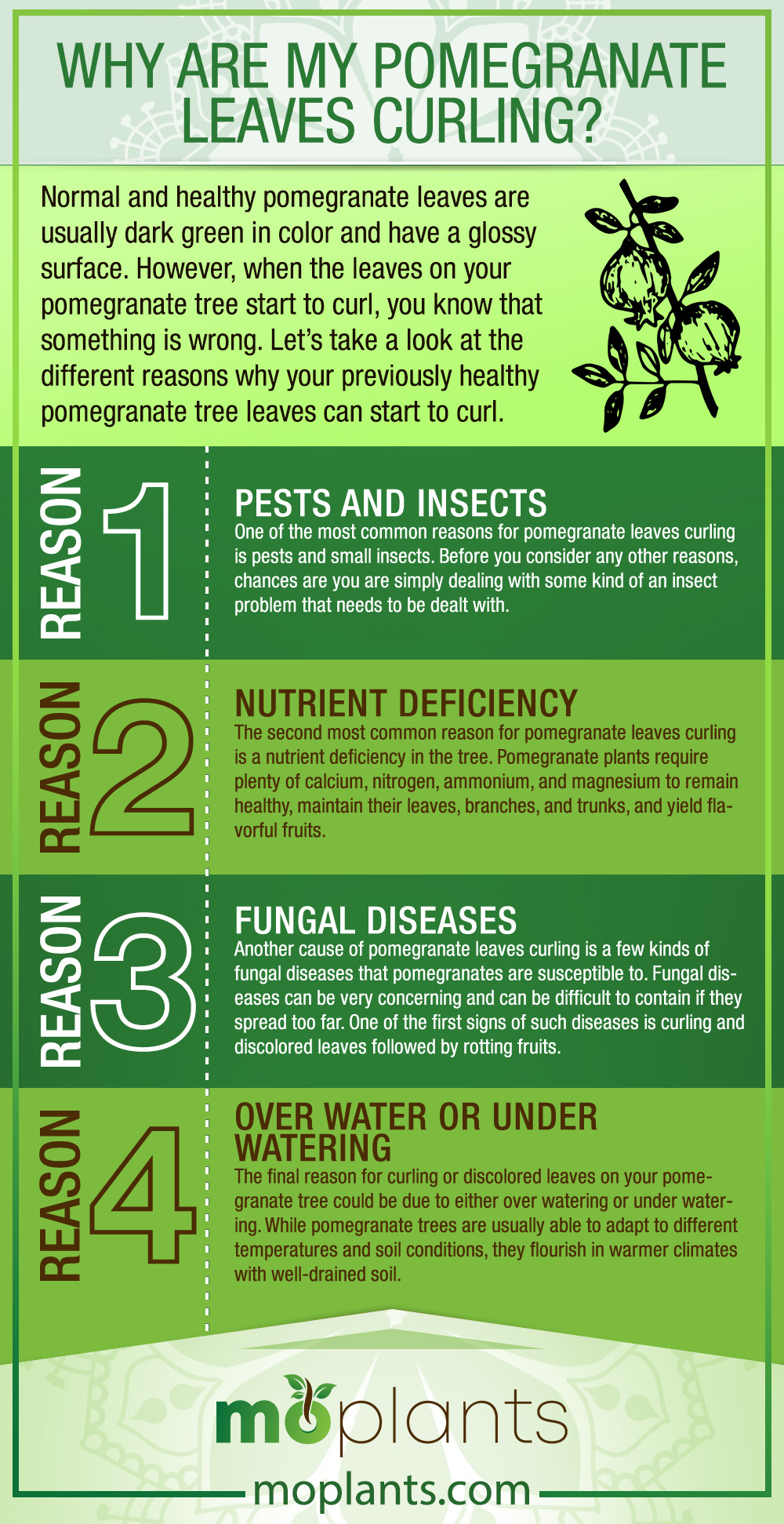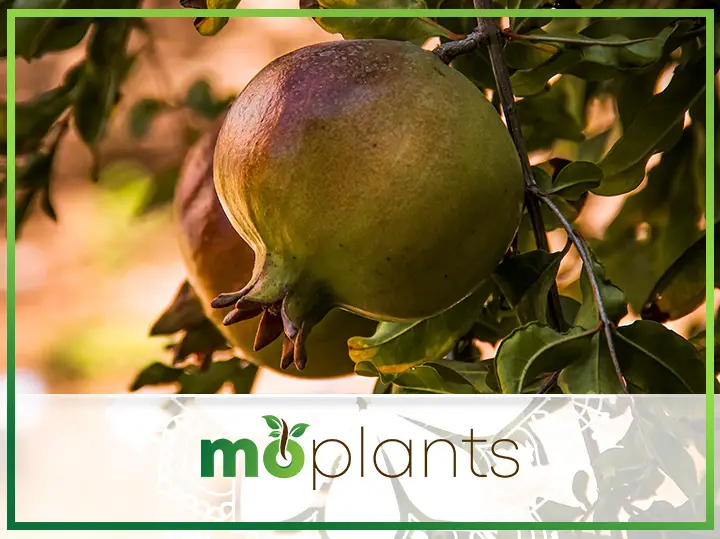Pomegranate seeds are juicy, sweet, sour, and overall incredibly delicious. Pomegranates are also rich in many nutrients and vitamins, such as potassium, vitamin C, and vitamin K. A glass of pomegranate juice can be super refreshing on a hot summer’s day while also giving you lots of strength and energy. When there are so many benefits to eating a pomegranate, it’s no wonder why so many people prefer to grow their own pomegranate trees!
If you are someone that has a pomegranate tree growing in your home, you’ll know just how much care and patience it takes to maintain the tree. Not only do they take months to grow into a substantial size, but the blossoms don’t come in until the plant is at least a year old. As for the fruit itself, you often have to wait three to five years to see the first ones emerge.
With so much time and effort going into growing and maintaining pomegranate trees, it can be very devastating to find anything going wrong. One problem that many people often find when it comes to their pomegranate plants is curling leaves.
What does it mean when you see pomegranate leaves curling? And should you be worried about the overall health of your tree? What are the causes for it, and how can you treat it? And finally, are there steps you can take to prevent curling leaves? Read ahead to find the answers to all of these different questions.
Should I Be Worried If the Leaves on Your Pomegranate Tree Start Curling?
It may take some time before you really even notice the curling leaves on your pomegranate tree. When you do finally notice them, you might find yourself wondering if this is something to be worried about or whether it’s not a big deal. The truth is, curling leaves indicates that something is wrong with your plant, and it is important to find out the underlying cause for the leaves curling.
If left untreated, your pomegranate plant can eventually suffer and die, which is the last thing you want. Curling leaves are usually the first sign that your plant is in trouble, and they should be taken seriously. Once you know why the leaves are curling, you can take measures to help your plant get back to its previous healthy and happy condition.
Why Are My Pomegranate Leaves Curling?
Normal and healthy pomegranate leaves are usually dark green in color and have a glossy surface. They have a simple shape and are usually narrow oblongs. You’ll usually find a number of leaves glowing clustered together on the branches of the tree. As the weather gets cooler, you can expect the leaves to start turning brown and slowly fall off. This isn’t any cause for worry as new leaves begin growing in the spring.
However, when the leaves on your pomegranate tree start to curl, you know that something is wrong. You’ll notice that the tips of the leaves start to change color, usually turning yellow or brown, and curl downwards and inwards. You might also see some black, moldy spots on the leaves.
Let’s take a look at the different reasons why your previously healthy pomegranate tree leaves can start to curl.
Reason 1: Pests and Insects
One of the most common reasons for pomegranate leaves curling is pests and small insects. Before you consider any other reasons, chances are you are simply dealing with some kind of an insect problem that needs to be dealt with.
Sucking insects like aphids, whiteflies, mealybugs, and scales are the insects you most need to worry about. These small insects are usually difficult to see, especially when they’re high up in a tree. Their diet consists of the sap found in various plant leaves, including pomegranate leaves. As the insects feed, the sap in the leaves is depleted, causing the leaves to curl inwards. These insects also leave behind honeydew on the leaves, which can attract mold over time, leading to black mold spots along with the curling leaves.
If you use chemical insecticides and pesticides, you may actually be worsening your problem instead of helping it. There are many beneficial insects such as lacewings, syrphid flies, and lady beetles that fight against aphids, whiteflies, mealybugs, and scales. Overuse of insecticides and pesticides might end up killing beneficial insects rather than pest insects. In order to kill off pest insects, you can introduce lacewings, syrphid flies, and lady beetles to your pomegranate tree.
Another thing you can do is switch from chemical insecticides and pesticides to natural ones such as neem oil or horticulture oils. However, keep in mind that these oils are only effective when they come in direct contact with pest insects. This means you need to make sure you spray every leaf thoroughly and might have to reapply the oils multiple times over the span of a few days.
Reason 2: Nutrient Deficiency
The second most common reason for pomegranate leaves curling is a nutrient deficiency in the tree. Pomegranate plants require plenty of calcium, nitrogen, ammonium, and magnesium to remain healthy, maintain their leaves, branches, and trunks, and yield flavorful fruits. If your pomegranate tree is not receiving enough of the nutrients it needs, the leaves can start to curl inwards and resemble a hook-like shape. The tips of the leaves can also become discolored.
The easiest way to deal with a nutrient deficiency would be to introduce some micronutrient-rich fertilizer to your soil. In general, it would be a good idea to use an ammonium sulfate fertilizer or a fertilizer that is high in nitrogen content. Some people prefer using a 10-10-10 formula. If you’re not too sure which fertilizer would suit your pomegranate plant best, you can get advice from your local nursery or gardening center, as they would be able to guide you better depending on where you live and what kind of soil and climate you have.
You should fertilize your pomegranate plant three times a year: at the beginning of spring, late spring, and early fall. As your pomegranate tree grows bigger, you have to keep increasing the amount of fertilizer you use until you max out at 8 ounces of fertilizer per application. A good tip to keep in mind when applying fertilizer is to avoid digging into the roots. Instead, keep to the surface so that the roots do not get disturbed.
Additionally, you can also remove other vegetation like grass or smaller plants that are near the tree and are competing with it for nutrients from the soil. Alongside the fertilizers, you can use organic mulch and compost to help the soil regain its vital nutrients.
Reason 3: Fungal Diseases
Another cause of pomegranate leaves curling is a few kinds of fungal diseases that pomegranates are susceptible to. Fungal diseases can be very concerning and can be difficult to contain if they spread too far. One of the first signs of such diseases is curling and discolored leaves followed by rotting fruits.
There are three fungal diseases you need to look out for.
- Alternaria Fruit Rot, aka black rot, causes the pomegranate fruits to rot from the inside. It is often a result of excessive water and moisture when the fruit is still young, such as from heavy rainfall.
- Aspergillus Fruit Rot is very similar to Alternaria in the way that it infiltrates the fruit and causes it to rot.
- Botrytis is a gray mold that grows on several tropical fruits, including pomegranates. This mold usually hibernates while the fruits grow. Once the fruits have been harvested and are washed for the first time, the mold becomes activated and can spread to all the other harvested fruit.
The way to cure and control fungal diseases in your pomegranate plant is by using copper fungicides, but this is more of a preventative measure rather than a curative one. If you find that fungal diseases have spread to the leaves, fruits, and branches of your pomegranate tree, your best line of approach would be pruning and cutting off the affected parts.
An overall healthy tree can quickly recover once the affected parts are pruned and cut off. After that, you can expect new healthy growth in the summer.
Reason 4: Over Water or Under Watering
And lastly, the final reason for curling or discolored leaves on your pomegranate tree could be due to either over watering or under watering. While pomegranate trees are usually able to adapt to different temperatures and soil conditions, they flourish in warmer climates with well-drained soil. Too much moisture can result in curling leaves or rotting roots and trunks. On the other hand, too little water can also be damaging.
If your pomegranate tree is planted in light soil, you should water it two times a week. If the soil is more clay-like, then once a week should suffice. You should soak the root system very well and give the tree about one inch of water per week.
Infographic

Pruning Is Essential for A Healthy Pomegranate Tree
We’ve talked in detail about the various cases of pomegranate leaves curling and what you can do to try and remedy the problem: from using insecticides and pesticides to adding fertilizers and mulch and even controlling how much water you’re giving the tree. While all of this is essential and very necessary in maintaining the health of your pomegranate plant, there is one more thing that you need to do. That is pruning!
Regular pruning not only keeps your pomegranate tree healthy and allows for a higher yield of fruit, but it also gives you the opportunity to get up close and personal with your tree. This means that if there is any concerning leaf curling happening, you’ll catch it soon and be able to treat it accordingly.
Let’s do a quick rundown on when and how you should be pruning your pomegranate tree. To start with, you should cut away any weak, thin, awkwardly placed, or diseased branches on the tree. Suckers growing out from the roots that are not close to the main trunk of the tree should also be cut away. This type of pruning should be carried out once a year and helps your tree stay healthy by allowing more sunlight and air to reach it and for it to have a stronger trunk.
If you want to prune your pomegranate tree to get a higher yield of fruit, focus your pruning on the external branches of the tree. New growth from these branches will emerge in the spring and likely bring with it new blossoms and more fruits. This kind of pruning is best carried out in winter so that the new growth emerges at the beginning of the spring season.
The Bottom Line
So, now that you’ve gone through the whole article with us, we hope that you have a better idea of how to keep your pomegranate tree growing well, healthy, and happy. While it is very important to make sure that the tree is receiving enough sunlight, water, nutrients, and protection from harmful insects, you should also make sure to check your tree for any weak spots.
Inspect the leaves frequently to see if they are healthy and not curling, inspect the truck on the tree to make sure it is dry and solid, and keep an eye on the roots, trimming off any extra suckers if you see them. Now that you know everything you need to know about why pomegranate leaves might curl, you can prevent it from happening and ensure that your pomegranate plants remain healthy and yield lots of fruits, too.


